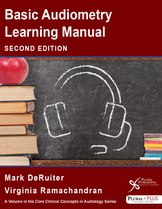Publication
Basic Audiometry Learning Manual
- Second Edition
- Details:
- 216 pages, Color Illustrations (2 Color), Spiral Bound, 8.5 x 11" 1 lbs
- Included Media:
- Companion Website
- ISBN13:
- 978-1-59756-865-4
- Release Date:
- 02/15/2016
Overview
Basic Audiometry Learning Manual, Second Edition is designed to provide students and beginning clinicians with instruction in the art and science of clinical audiometry techniques. Well-defined learning outcomes, review of concepts, observation exercises, guided practice, and review materials serve as catalysts for active learning of concepts and provide opportunity for utilization of fundamental audiometry methods. The comprehensive content of the Learning Manual encompasses the breadth of audiologic evaluation, including history taking and patient communication, ear canal assessment and management, immittance, pure-tone testing, masking, speech audiometry, otoacoustic emissions, patient counseling, and report writing. This text is designed to cultivate the successful learning of students and entry-level professionals.
Each chapter in this second edition has been updated to reflect current standards of practice. Additional updates include:
- Two new chapters on physiologic measurements, including otoacoustic emissions, as well as common challenges and pitfalls of the new clinician
- Enhanced information on audiogram interpretation and auditory pathology
- More detailed information on acoustic reflexes
- Enhanced information on reporting
- Further delineation and clarification of masking concepts
- Access to companion website with audiograms for interpretation and videos of common procedures
The Learning Manual consists of various components designed to engage students through active learning. Learning Outcomes provide students with clear goals for knowledge and skill-building and provide a foundation for students to evaluate their progress toward clinical competence outcomes. Review of Concepts provides a concise examination of the theoretical knowledge necessary for performance of clinical activities. Observation challenges students to witness the behavior of clinical instructors or practicing professionals in the act of clinical practice. Guided Practice leads the student through exercises designed to provide firsthand experience with performing clinical activities. Reflection and Review provides students with opportunities to incorporate newfound understanding gained through Observation and Guided Practice into their theoretical and conceptual knowledge base through answering reflective and review questions.
Chapters can be taught in a serial fashion, following the sequence of a typical audiologic evaluation. Alternatively, the order of activities can be tailored to suit a particular instructional curriculum, or as individual topics coalesced with immediate goals.
This second edition of the Basic Audiometry Learning Manual includes a PluralPlus companion website where instructors and students will find audiograms for interpretation and videos of common procedures.
Sample video from the companion website:
Preface
Chapter 1. Greeting the Patient
Chapter 2. The Patient Interview
Chapter 3. Otoscopic Examination
Chapter 4. Immittance Instrumentation
Chapter 5. Tympanometry
Chapter 6. Acoustic Reflex Thresholds
Chapter 7. Acoustic Reflex Decay
Chapter 8. Audiometer Instrumentation
Chapter 9. Biologic Check of Audiometer Instrumentation
Chapter 10. Obtaining a Threshold
Chapter 11. Obtaining an Unmasked Air-Conduction Audiogram
Chapter 12. Obtaining an Unmasked Bone-Conduction Audiogram
Chapter 13. Masking
Chapter 14. Speech Thresholds
Chapter 15. Word Recognition Testing
Chapter 16. Masking for Speech Audiometry
Chapter 17. The Stenger Test
Chapter 18. Tuning Fork Tests
Chapter 19. Otoacoustic Emissions
Chapter 20. Interpreting Test Results
Chapter 21. Counseling the Patient
Chapter 22. Reporting Results
Chapter 23. Common Pitfalls in Audiologic Evaluation
References and Bibliography
Index
About The Authors
Mark DeRuiter, MBA, PhD is director of graduate studies and clinical programs in the Department of Speech-Language-Hearing Sciences at the University of Minnesota-Twin Cities Campus, where he earned his doctorate. He oversees the Julia Davis Speech-Language-Hearing Center and teaches coursework in counseling and professional issues.
Virginia Ramachandran, AuD, PhD, is a senior staff audiologist and research coordinator in the Division of Audiology, Department of Otolaryngology-Head and Neck Surgery of the Henry Ford Health System in Detroit, Michigan.
Related Titles
Rotational Vestibular Assessment
322 pages, Color Illustrations (4 Color), Softcover, 8.5 x 11"
Pure-Tone Audiometry and Masking
255 pages, Color Illustrations (4 Color), Softcover, 5 x 7.5"
Objective Assessment of Hearing
James W. Hall III, De Wet Swanepoel
200 pages, Color Illustrations (2 Color), Softcover, 7 x 10"
Speech Audiometry
Gary D. Lawson, Mary E. Peterson
192 pages, Illustrated (B/W), Softcover, 8.5 x 11"
Electronystagmography/Videonystagmography (ENG/VNG)
224 pages, Color Illustrations (2 Color), Softcover, 8.5 x 11"
Acoustic Immittance Measures
175 pages, Illustrated (B/W), Softcover, 8.5 x 11"
Programming Cochlear Implants
408 pages, Color Illustrations (2 Color), Softcover, 8.5 x 11"
Purchasers of this book receive complimentary access to supplementary materials hosted on a PluralPlus companion website.
Materials:
- Cases (audiograms for interpretation)
- Videos of common procedures
To access the materials, log in to the website using the URL and Access Code located inside the front cover of your copy of Basic Audiometry Learning Manual, Second Edition.
















